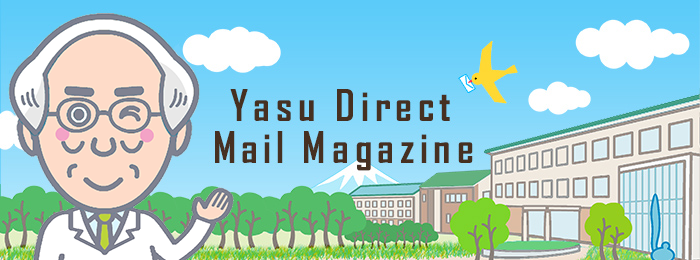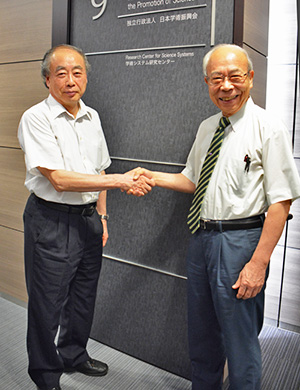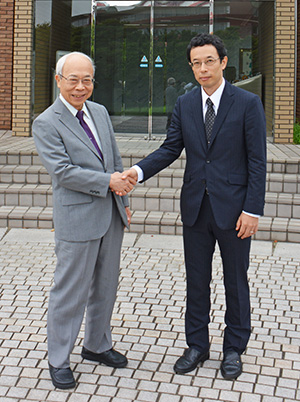No. 7 (November 9, 2015)


Yasu Direct Mail Magazine No. 7 (November 9, 2015)
Fall is the "season for study" ("season for eating," too?), so now that we are well into fall I'm sure everyone is hard at work as always on their studies and research.
The other day, as part of new Conversations with the President series organized by The Japan Association with National Universities, I had the opportunity to speak with SOKENDAI Professor Emeritus Makoto Kobayashi, recipient of the Nobel Prize in Physics. The following day, I also spoke with the first recipient of the SOKENDAI Scientist Award, SOKENDAI alumnus Shin Nakamura. Summaries of these conversations are available on the SOKENDAI website (Note 1). (Its English translations will be available soon.) The conversations are inspiring and there is much to learn from them, so I would encourage everyone to give them a read.
Listening to Prof. Kobayashi I was especially struck by his observation that the spread of knowledge, as the product of free thought and diversity, is ensured only through basic funding, as well as his view that Nobel Prize-level research requires a broad perspective and ability to see the big picture or to command a bird's-eye view. What troubles me about his observation that basic funding must be secured if free thought and diversity are to be ensured, is the fact that government funding of operating budgets at the national universities has fallen 1% annually over the past 12 years (in other words, a total of 12%), leaving university operations in a precarious state. Our instructors and researchers are burdened with miscellaneous tasks and expected to produce work that is "ready for the exit" (that is, immediately useful to industry). It is no longer a place of free thought and diversity. Thanks to research done 15-35 years ago, when funding for both scientific research and operating budgets was growing, Japan today has been producing a wonderful number of Nobel laureates. Yet 12 years ago the number of publications originating in Japan stopped growing and now Japan's share of publications in the world has fallen sharply, even as the number of articles published in other countries around the world has continued to grow (Note 2). At this rate, in 10 to 20 years from now Japan will no longer be producing Nobel laureates, I am afraid. Worse still, Japanese society and industry will have fallen irreparably behind. Regarding Prof. Kobayashi's view that research requires a broad perspective and ability to see the big picture, SOKENDAI's Freshman Course, which all entering students take, already provides inter-departmental general education on science and learning in relation to society. Additionally, starting next fiscal year we also have plans to offer a general education program tentatively called "Grand United Natural History" (what I previously referred to as the "Hayama Course") through which students will develop a 4th-dimensional, top-level perspective on their own research in relation to natural and human history.

Listening to Prof. Nakamura, I was deeply struck by his observation that broadening one's perspective through cross-disciplinary and cross-cultural encounters can lead to the discovery of big research topics, and his view that researchers need to use Japan's "craftsman" aesthetic and follow their own path based on creativity not restricted by or unbeholden to conventional thinking or common sense. Prof. Nakamura's observations on the importance of cross-disciplinary and cross-cultural encounters resonate strongly with the founding ideals of SOKENDAI, a graduate university without undergraduate colleges. They are the antithesis, he stressed, of the detrimental side of Japanese education with its low fluidity or less mobility of students, instructors and researchers, and its tendency to compartmentalize learning. Beginning next fiscal year SOKENDAI also plans to offer an internship program that will enable students to visit different domestic and foreign universities and research institutions as part of SOKENDAI's inter-departmental education program so students can learn what they need to, when they need it. Prof. Nakamura's view that researchers need to possess both a "craftsman" aesthetic and creativity unbeholden to conventional thinking is the reflection of an artisan aesthetic that, if left compartmentalized, runs the risk of culminating in little more than self-satisfaction. If, however, it is applied in combination with a creativity not restricted by conventional thinking along a path that crosses existing boundaries, then it becomes a force for innovation based on an approach different from that of Europe and the U.S. (as when Hideki Yukawa startled the world). At the same time, deciding on a new path that is unbeholden to conventional thinking is, I believe, something that requires the kind of broad perspective and big-picture view described by Prof. Kobayashi.
My conversations with Prof. Kobayashi, an emeritus professor as remarkable for his insights as for his record of achievement, and Prof. Nakamura, an alumnus bursting with creativity and energy, remind me of how extremely proud I am of SOKENDAI. I got the impression that both them benefitted greatly from the kinds of discussion and exchange they both had with many individuals from different fields of study. In terms of quality, The Inter-University Research Institutes and other locations where SOKENDAI students study are (or become) the same as the Sakata Lab for Prof. Kobayashi or the cross-disciplinary community of international researchers that Prof. Nakamura joined. I look forward to working together with the SOKENDAI faculty to ensure an environment in which our students become the 'Kobayashi's and 'Nakamura's of the future.
I call on you, our students, to take advantage of SOKENDAI's four strengths -- 1) our Inter-University Research Institutes and Institute of Space and Astronautical Science that provide a world-leading international research environment, 2) our advanced specialized education and inter-departmental general education programs supported by a high faculty-to-student ratio (over 2 to 1) and , 3) our high rate of success in developing researchers, and 4) our diverse population of students from domestic and foreign universities who have overcome many obstacles to enroll -- as you dedicate yourselves to your studies and research. If you do, your individual path to the future will open before you.
I sincerely hope each of you is leading an enjoyable, fulfilling and rich life as students during your time here. Until next time!
(Note 1) The conversations are available through the five links below.
(Note 2) The stagnant rate of Japanese publications and falling share of publications in the world are discussed in detail in a recent article, "Severe Shock: The University Rankings (Part 2)," by Masashi Shirabe in The Nikkei (Oct. 26, 2015). The important points about this situation are, first, that Japan's total number of publications, which had grown continually since 1981, stopped growing entirely beginning in 2003 (the very year that funding to national universities for operating budgets was cut). As a result, Japan's share of publications in the world today has continued to fall sharply (even as globally the total number of publications has continued to grow), lowering Japan's share in 2013 to a level below that of even 1981. Second, while the number of citations in a particular field of research provides a certain measure of publication quality, Japan's share of cited publications among the top 1% and top 10% in the world has also continued to fall. As a result, Japan's share of the top 1% and top 10% of publications in 2013 has actually fallen below what they were 20 and 30 years ago, respectively.
